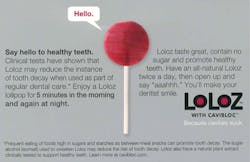There's a new beneficial sweet in town . . . and it doesn't contain xylitol
All-natural, herbal lollipops and lozenges inhibit Streptococcus mutans, Streptococcus sobrinus, and Lactobacillus casei in the oral cavity
Here's something to suck on: Two sweets a day will keep caries away.
OK, OK—that's not how the saying goes. But that could very well change, as Loloz with Cavibloc gains momentum on the market for adjunctive caries prevention products.
Whether you're a clinician or an industry professional, you've most likely heard of xylitol, the sugar alcohol that has taken the dental industry by storm in recent years, due to its potential to reduce decay and promote remineralization. Perhaps you've also heard a thing or two about erythritol, another sugar alcohol considered to be beneficial that has been the subject of some recent microbiological studies.
Loloz is a sweet new adjunctive option that does not contain either of the above. (In fact, it contains isomalt and stevia, but we'll get to that later.) It's an all-natural, herbal lollipop or lozenge—available in the flavors of berry, orange, and lemon—that can help to prevent caries when used as directed and as part of a caries management routine. It's also the commercial outcome of approximately seven years of research, which led to the development of the proprietary active ingredient, Cavibloc, an inhibitor of Streptococcus mutans, Streptococcus sobrinus, and Lactobacillus casei.
If it's not xylitol, what is "Cavibloc?"
What is now branded as Cavibloc was developed at the University of California, Los Angeles (UCLA) by a team of researchers led by Wenyuan Shi, PhD, an oral microbiologist who chairs the department of oral biology at UCLA. Dr. Shi is also the founding scientist of C3 Jian, a private biotechnology company focusing on oral health. He recently shared with us how he and his team came to develop the compound. Here's the short story . . .
C3 Jian had been actively working its way through the FDA's regulatory processes for pharmaceutical development for its novel anti-cavity drug, C16G2, when Dr. Shi and his team decided to pursue an intermediate solution-something that wouldn't require the same costly and time-consuming regulatory processes as C16G2. The solution, they decided, needed to be nutritive.
_________________________________________________
Did "anti-cavity drug" catch your eye? C3 Jian's anti-cavity drug, C16G2, is currently in the FDA's Phase 2 of clinical trials. Read about it at www.c3-jian.com.
_________________________________________________
Originally from China, Dr. Shi looked to traditional Chinese medicine for herbs that could offer the desired benefits. And what he found were approximately 2,000 herbs to consider. A broad, systematic screening was in order. Fortunately, he and his team already had the appropriate biological assays on their side, as they'd needed to develop them for C16G2. They completed an estimated 50,000 tests for efficacy, and roughly five or six herbs showed some results . . . but the major breakthrough was a Chinese licorice root (Glycyrrhiza uralensis) extract.
________________________________________________________
Fun fact: The literature review conducted by Dr. Shi and his team confirmed that various cultures around the globe had been using licorice root (typically by chewing it) to promote oral health for a very, very long time.
________________________________________________________
So, Shi and his team conducted a literature review and examined the chemical structure of the extract to determine the mechanism of action. What they found was promising news for dentistry's ongoing battle against the caries epidemic: The extract was semi-targeted to inhibit harmful bacteria in the oral environment—including Streptococcus mutans, Streptococcus sobrinus, and Lactobacillus casei.
Licorice root extract, meet HealthyGrid
When Andrew Clapp and Sam Dyer of HealthyGrid-—a Moda Health subsidiary based in Portland, Oregon—heard about Dr. Shi's research on the extract, C3 Jian happened to be preparing to sell the patent.
"We got excited and we pounced on it," said Dyer during a recent interview. The extract seemed like the perfect fit for HealthyGrid's product line, which already included HealthyGrid xylitol candies and Dental Optimizer, a dental directory and informational resource for consumers who are looking for dentists or dental practices. They discussed applications for the extract with Dr. Shi, and the answer seemed clear: The extract would need to be delivered in a "candy."
"We knew that 'candy' was the best way to deliver it since it has to be in contact with your mouth for a certain period of time [five minutes] and since it has huge potential for the geriatric demographic as well as the pediatric demographic," said Clapp. But to develop the product, they needed to start from scratch in what would prove to be an exciting albeit lengthy process.
"When we first acquired the patent, getting the compound that we needed extracted [from the licorice root] took some time," said Dyer. Batches of the extract had to be tested by Dr. Shi multiple times before being added to the candy and once afterward, due to variations in the potency of the extract that occur naturally based on where and how the licorice root is grown. "There were three different companies we worked with [. . .] and eventually, one of them got it right, and they got it right to the point where it was even more effective than what we needed," said Dyer.
Getting the flavor right was another challenge, as licorice root extract naturally has a somewhat earthy flavor. Moreover, the formula needed to be just right for the "candy" to be effective as a delivery mechanism since the extract—now branded as Cavibloc—must remain in the mouth for a total of five minutes to effectively inhibit the growth of harmful bacteria. To keep the pH balance at an appropriate level for the oral microbiome, isomalt and stevia were selected as sweeteners.
"Every step of the way, every change that we made, we were testing the efficacy," said Clapp.
The other active ingredient? A "sticky" marketing strategy
While much can be said about the proprietary Cavibloc, you could say that the other active ingredient is a fresh marketing strategy. While a "candy" seemed perfect for the delivery method, it wasn't quite right for introducing the product to HealthyGrid's target market of dental professionals and patients.
"We felt like the biggest thing this product needed was to be better positioned—not sold as a candy [but] distinguished as a way to fight cavities," said Dyer. "We're not really trying to compete with sugar-free candies. That's not our market. We're not even trying to compete with xylitol, which is [. . .] a great sugar-free alternative to sugary sweets. We're not there to be the go-to candy when you have a sweet tooth. This really is a protocol and an anti-cavity regimen, so we want to make sure that people are using this as a way to prevent and halt tooth decay. [. . .] We want people to treat this as a prevention tool."
Working with the Portland-based Sandstrom Partners, they set out to develop a plan for the marketing and packaging of the product that would strike a balance between "fun" and "healthy."
"We tried to [develop a marketing strategy] that was 'sticky,'" added Clapp. What they created was Loloz with Cavibloc, which is delivered in a package looking "almost like a tea box with very specific instructions," to use Clapp's words.
Conveying that the product is a prevention tool was (and is) critical for HealthyGrid, as the Cavibloc doesn't offer the same results unless Loloz are used as directed: for five minutes in the morning and five minutes at night for 10 days, two to four times per year between dental visits (and, of course, in conjunction with a regular brushing and flossing routine!).
On the other hand, a little bit of fun was also necessary. "You know, in people's minds, the dentist isn't always really a fun thing. And we want your health to be fun," said Clapp.
If you're a dental professional, and your go-to caries management protocol isn't working for a patient—whether it's because the patient doesn't comply or because he or she is just that prone to decay—offering a way to help manage the oral microbiome might just be the next step.
___________________________________
Editor's Note: Launched during the spring of 2015, Loloz with Cavibloc is available through HealthyGrid, at Loloz.com, and on Amazon. Dentists can purchase the product for $19.99. The suggested retail price is $29.99.
About the Author

Erin Robinson
Erin Robinson, MA, is an associate editor in the dental group at Endeavor Business Media (formerly PennWell). Prior to joining the dental team at PennWell, she completed a master's degree at the University of Tulsa, where she taught professional writing to students majoring in business, engineering, and the natural sciences. To contact her or submit an article, email [email protected].


